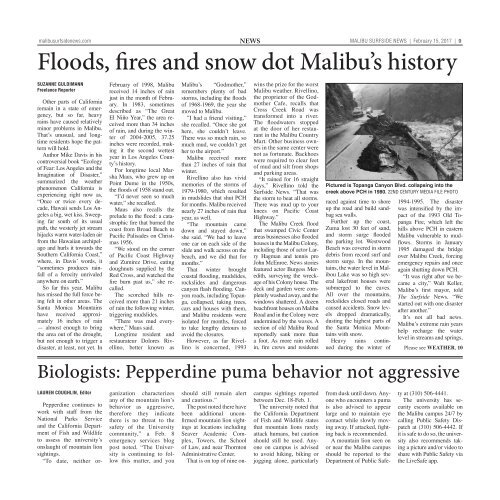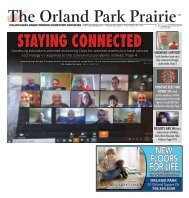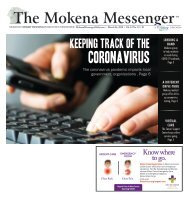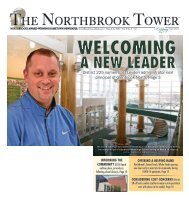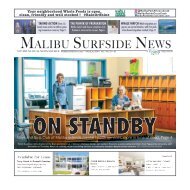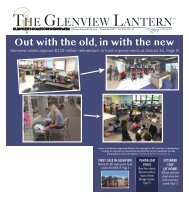MSN_021517
Malibu Surfside News 021617
Malibu Surfside News 021617
Create successful ePaper yourself
Turn your PDF publications into a flip-book with our unique Google optimized e-Paper software.
malibusurfsidenews.com News<br />
Malibu surfside news | February 15, 2017 | 9<br />
Floods, fires and snow dot Malibu’s history<br />
Suzanne Guldimann<br />
Freelance Reporter<br />
Other parts of California<br />
remain in a state of emergency,<br />
but so far, heavy<br />
rains have caused relatively<br />
minor problems in Malibu.<br />
That’s unusual, and longtime<br />
residents hope the pattern<br />
will hold.<br />
Author Mike Davis in his<br />
controversial book “Ecology<br />
of Fear: Los Angeles and the<br />
Imagination of Disaster,”<br />
summarized the weather<br />
phenomenon California is<br />
experiencing right now as,<br />
“Once or twice every decade,<br />
Hawaii sends Los Angeles<br />
a big, wet kiss. Sweeping<br />
far south of its usual<br />
path, the westerly jet stream<br />
hijacks warm water-laden air<br />
from the Hawaiian archipelago<br />
and hurls it towards the<br />
Southern California Coast,”<br />
where, in Davis’ words, it<br />
“sometimes produces rainfall<br />
of a ferocity unrivaled<br />
anywhere on earth.”<br />
So far this year, Malibu<br />
has missed the full force being<br />
felt in other areas. The<br />
Santa Monica Mountains<br />
have received approximately<br />
16 inches of rain<br />
— almost enough to bring<br />
the area out of the drought,<br />
but not enough to trigger a<br />
disaster, at least, not yet. In<br />
February of 1998, Malibu<br />
received 14 inches of rain<br />
just in the month of February.<br />
In 1983, sometimes<br />
described as “The Great<br />
El Niño Year,” the area received<br />
more than 34 inches<br />
of rain, and during the winter<br />
of 2004-2005, 37.25<br />
inches were recorded, making<br />
it the second wettest<br />
year in Los Angeles County’s<br />
history.<br />
For longtime local Marsha<br />
Maus, who grew up on<br />
Point Dume in the 1950s,<br />
the floods of 1958 stand out.<br />
“I’d never seen so much<br />
water,” she recalled.<br />
Maus also recalls the<br />
prelude to the flood: a catastrophic<br />
fire that burned the<br />
coast from Broad Beach to<br />
Pacific Palisades on Christmas<br />
1956.<br />
“We stood on the corner<br />
of Pacific Coast Highway<br />
and Zumirez Drive, eating<br />
doughnuts supplied by the<br />
Red Cross, and watched the<br />
fire burn past us,” she recalled.<br />
The scorched hills received<br />
more than 21 inches<br />
of rain the following winter,<br />
triggering mudslides.<br />
“There was mud everywhere,”<br />
Maus said.<br />
Longtime resident and<br />
restaurateur Dolores Rivellino,<br />
better known as<br />
Malibu’s “Godmother,”<br />
remembers plenty of bad<br />
storms, including the floods<br />
of 1968-1969, the year she<br />
moved to Malibu.<br />
”I had a friend visiting,”<br />
she recalled. “Once she got<br />
here, she couldn’t leave.<br />
There was so much rain, so<br />
much mud, we couldn’t get<br />
her to the airport.”<br />
Malibu received more<br />
than 27 inches of rain that<br />
winter.<br />
Rivellino also has vivid<br />
memories of the storms of<br />
1979-1980, which resulted<br />
in mudslides that shut PCH<br />
for months. Malibu received<br />
nearly 27 inches of rain that<br />
year, as well.<br />
“The mountain came<br />
down and stayed down,”<br />
she said. “We had to leave<br />
one car on each side of the<br />
slide and walk across on the<br />
beach, and we did that for<br />
months.”<br />
That winter brought<br />
coastal flooding, mudslides,<br />
rockslides and dangerous<br />
canyon flash flooding. Canyon<br />
roads, including Topanga,<br />
collapsed, taking trees,<br />
cars and houses with them,<br />
and Malibu residents were<br />
isolated for months, forced<br />
to take lengthy detours to<br />
avoid the closures.<br />
However, as far Rivellino<br />
is concerned, 1993<br />
wins the prize for the worst<br />
Malibu weather. Rivellino,<br />
the proprietor of the Godmother<br />
Cafe, recalls that<br />
Cross Creek Road was<br />
transformed into a river.<br />
The floodwaters stopped<br />
at the door of her restaurant<br />
in the Malibu Country<br />
Mart. Other business owners<br />
in the same center were<br />
not as fortunate. Backhoes<br />
were required to clear feet<br />
of mud and silt from shops<br />
and parking areas.<br />
“It rained for 16 straight<br />
days,” Rivellino told the<br />
Surfside News. “That was<br />
the storm to beat all storms.<br />
There was mud up to your<br />
knees on Pacific Coast<br />
Highway.”<br />
The Malibu Creek flood<br />
that swamped Civic Center<br />
areas businesses also flooded<br />
houses in the Malibu Colony,<br />
including those of actor Larry<br />
Hagman and tennis pro<br />
John McEnroe. News stories<br />
featured actor Burgess Meredith,<br />
surveying the wreckage<br />
of his Colony house. The<br />
deck and garden were completely<br />
washed away, and the<br />
windows shattered. A dozen<br />
beachfront houses on Malibu<br />
Road and in the Colony were<br />
undermined by the waves. A<br />
section of old Malibu Road<br />
reportedly sank more than<br />
a foot. As more rain rolled<br />
in, fire crews and residents<br />
Pictured is Topanga Canyon Blvd. collapsing into the<br />
creek above PCH in 1980. 22nd Century Media File Photo<br />
raced against time to shore<br />
up the road and build sandbag<br />
sea walls.<br />
Further up the coast,<br />
Zuma lost 30 feet of sand,<br />
and storm surge flooded<br />
the parking lot. Westwood<br />
Beach was covered in storm<br />
debris from record surf and<br />
storm surge. In the mountains,<br />
the water level in Malibou<br />
Lake was so high several<br />
lakefront houses were<br />
submerged to the eaves.<br />
All over the mountains,<br />
rockslides closed roads and<br />
caused accidents. Snow levels<br />
dropped dramatically,<br />
dusting the highest parts of<br />
the Santa Monica Mountains<br />
with snow.<br />
Heavy rains continued<br />
during the winter of<br />
1994-1995. The disaster<br />
was intensified by the impact<br />
of the 1993 Old Topanga<br />
Fire, which left the<br />
hills above PCH in eastern<br />
Malibu vulnerable to mudflows.<br />
Storms in January<br />
1995 damaged the bridge<br />
over Malibu Creek, forcing<br />
emergency repairs and once<br />
again shutting down PCH.<br />
“It was right after we became<br />
a city,” Walt Keller,<br />
Malibu’s first mayor, told<br />
The Surfside News. “We<br />
started out with one disaster<br />
after another.”<br />
It’s not all bad news.<br />
Malibu’s extreme rain years<br />
help recharge the water<br />
level in streams and springs,<br />
Please see Weather, 10<br />
Biologists: Pepperdine puma behavior not aggressive<br />
Lauren Coughlin, Editor<br />
Pepperdine continues to<br />
work with staff from the<br />
National Parks Service<br />
and the California Department<br />
of Fish and Wildlife<br />
to assess the university’s<br />
onslaught of mountain lion<br />
sightings.<br />
“To date, neither organization<br />
characterizes<br />
any of the mountain lion’s<br />
behavior as aggressive,<br />
therefore they indicate<br />
there is no threat to the<br />
safety of the University<br />
community,” a Feb. 8<br />
emergency services blog<br />
post noted. “The University<br />
is continuing to follow<br />
this matter, and you<br />
should still remain alert<br />
and cautious.”<br />
The post noted there have<br />
been additional unconfirmed<br />
mountain lion sightings<br />
at locations including<br />
Seaver Academic Complex,<br />
Towers, the School<br />
of Law, and near Thornton<br />
Administrative Center.<br />
That is on top of nine oncampus<br />
sightings reported<br />
between Dec. 18-Feb. 1.<br />
The university noted that<br />
the California Department<br />
of Fish and Wildlife states<br />
that mountain lions rarely<br />
attack humans, but caution<br />
should still be used. Anyone<br />
on campus is advised<br />
to avoid hiking, biking or<br />
jogging alone, particularly<br />
from dusk until dawn. Anyone<br />
who encounters a puma<br />
is also advised to appear<br />
large and to maintain eye<br />
contact while slowly moving<br />
away. If attacked, fighting<br />
back is recommended.<br />
A mountain lion seen on<br />
or near the Malibu campus<br />
should be reported to the<br />
Department of Public Safety<br />
at (310) 506-4441.<br />
The university has security<br />
escorts available on<br />
the Malibu campus 24/7 by<br />
calling Public Safety Dispatch<br />
at (310) 506-4442. If<br />
it is safe to do so, the university<br />
also recommends taking<br />
a picture and/or video to<br />
share with Public Safety via<br />
the LiveSafe app.


